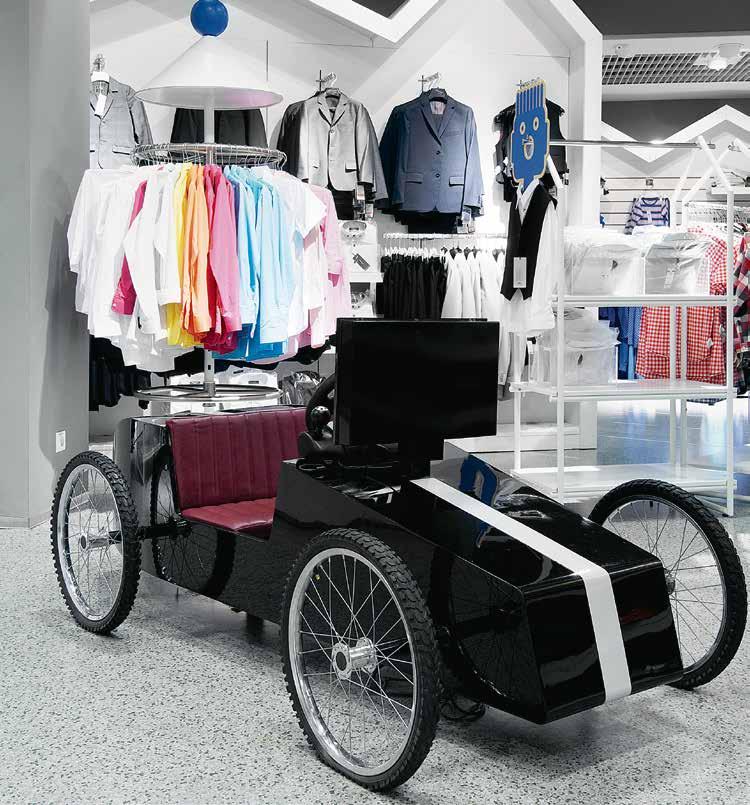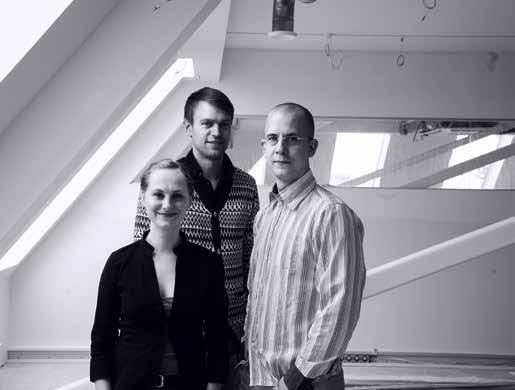
6 minute read
KAUBAMAjA LASTEMAAILM
from RUUMIPILT 2012
ruumilabor on loovbüroo, mille asutajateks on sisearhitektid janno Roos ja Andres Labi. Tänaseks on loodud bürookeskkondi, riigiasutuste esindusruume, hotelle, mitmeid kauplusi, kohvikuid ja restorane ning innovatiivseid näitusekujundusi. ruumilabori kaasabil valmis Eesti paviljoni projekt EXPo maailmanäitusele Shanghais.
Ruumilabor is a creative bureau, the founders of which are the interior architects Janno Roos and Andres Labi. By now they have created office environments, official rooms for governmental institutions, hotels, several shops, cafés and restaurants, and innovative exhibition designs. The Estonian pavilion project for the EXPO world exhibition in Shanghai was completed with the cooperation of Ruumilabor.
Advertisement
www.ruumilabor.ee
tallinn KaubaMaJa childrEn’s world
aadress/address: autorid/authors:
tellija/client: teostajad/implementation:
fotod/photos:
Gonsiori 2, Tallinn janno Roos, Andres Labi, Liisa Põime (Ruumilabor) Kaubamaja Kitman, RaSun, Hn Steel, ARS Sisustus
Kaido Haagen, Terje Ugandi, Reio Avaste

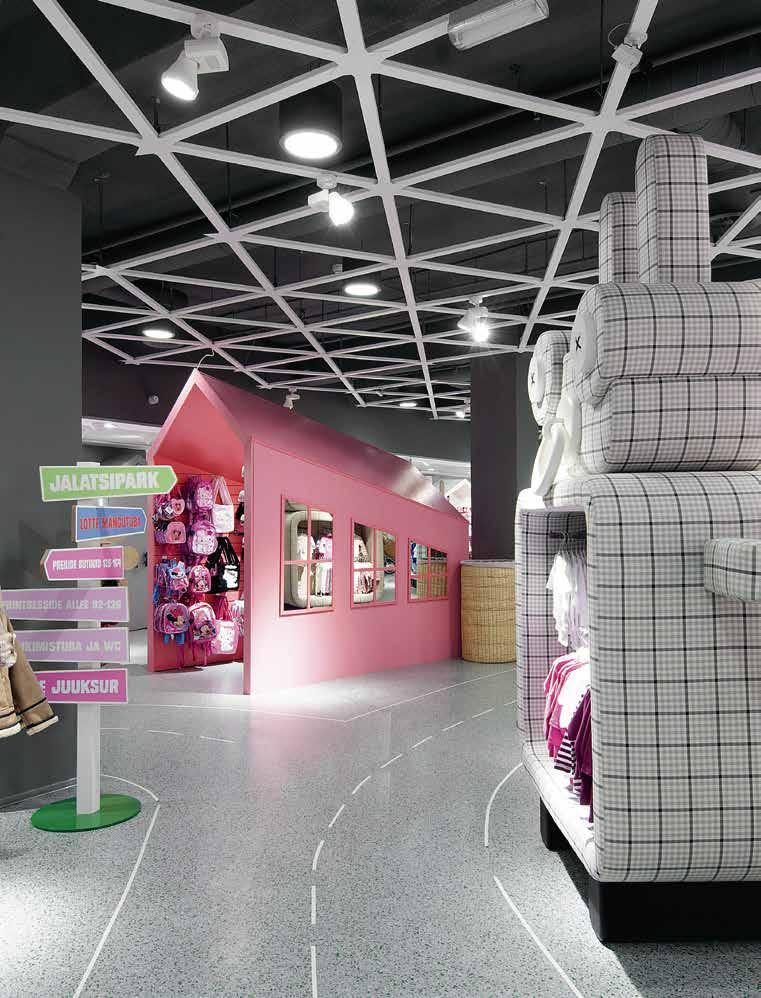
Põrandaplaan Floor plan
1m 5m
Lapsed elavad omas maailmas. Missugust maailma neile aga luua nii, et lapsedki seda omaks peaksid – on sisearhitektile mitme muutujaga võrrand. Mõistagi mänguline, samas ülifunktsionaalne.
Kuidas sisearhitektuuri projekt alguse sai, mis oli esimene visioon või kujutlus, mida teha? Milline oli lähteülesanne teile? Janno Roos (JR): Lastemaailmale tekkis täiesti uus ruum. Tellija pöördus meie poole, sooviga luua niisugune pood, mis ei oleks liiga lastepärane, et see kõnetaks ka lapsevanemat, kes ostu teeb. Laps aitab sellele kaasa, motiveerib, innustab vanemat midagi ostma lisaks vajadusele. Hakkasime kontseptsiooni otsima, mis meil seda pinda koos hoiaks, mis on omamoodi riiete virvarr. Mul tekkis idee luua linnakeskkond: linnaosad, tänavad, keskväljak, kellatorn ja mägi – kingamaastik kingapuuga. Andres Labi (AL): Tellija on hästi süsteemne, siin ei saakski teisiti – peab olema mingi väga tugev loogika ja omavahelised seosed, mis on meile väga hea alus. Skeem sünnib koostöös. JR: Tekkis paralleel, et Kaubamaja annab noodi ette, aga pillid on meie poolt. Pealtnäha võib tunduda kaos, aga siin on ka pool ruutmeetrit välja arvutatud, mida müüa, kus on fookus jne. Kaubamajal justkui ei olegi oma nägu, vaid iga osakond on oma nägu ja seda on inimestel huvitav avastada.
Kui vana see tegelane on, kes neid linnamaastikke peaks hoomama? JR: Linn on kõigile mõistetav, seal on tänavad ja majad, kus eraldi poiste ja tüdrukute tsoon vanuses kuni 16 aastat, eraldi beebid, eraldi kingamaastik. Loogika on selles, et igas linnaosas peaks olema mingisugune tõmbepunkt, mis köidab lapsi, kuni vanem tegeleb ostudega. Näiteks play-station-auto poistele, mis on nullist ehitatud – tegime seal katseid lastega, et saavutada õige ergonoomika. Tüdrukutele on arvutimänguga lamba moodi elukas. Kellatorniga tekitame lisapääsu, kust see maailm läheb edasi üles.
Kas kaubanduspinda on hea kujundada, kaup teid ei sega, kuidagi kitsaks ei jää? JR: Tegelikult on kõige hullem „vaba teema”. Teemasse mahtumine tähendabki seda, et sul on mingi raamistik ees ja mida tihedam see on, seda loomingulisem su töö saab olla, on väga palju muutujaid, millega pead arvestama. Mulle meeldib ka mõelda, et mida väiksem eelarve, seda rohkem pead panustama, et teha head asja. Kaubanduses on eelarve tavaliselt piiratud ja seega väljakutse meile. AL: Mulle istub see kontsentreeritus – reeglina on tööaega väga vähe ja teema konkreetne, ühesõnaga, hea on teha.
Olete ise ka lapsevanemad? JR: Mina olen. Kui me seda kavandasime, siis ma veel ei olnud. Tagantjärele olen tajunud, et mingid asjad on õigesti läinud. Lapsed ei ole konservatiivsed, seepärast on sinna lisatud teine tahk, kuidas luua erinevaid perspektiive: lapsevanema silma kõrgus, mis on vaoshoitud, loogiline ja süsteemne, millele lisandub rohujuure tasand, kus laps liigub, seal me ei ole tagasi hoidnud – detaili, mis last rõõmustaks, on piisavalt.
Children live in their own world. The kind of world that should be created for them, however, so that children themselves would consider it their own – is an equation with many variables for the interior architect. Needless to say, it is playsome, yet at the same time very functional.
How did this interior architecture project start? What was the first vision or image of what to do? What original task was given to you? Janno Roos (JR): An entirely new space was created for Children’s World. The customer turned to us with the wish to create the kind of store that wouldn’t be too child-oriented, which would also address children’s parents who make the purchases. The child cooperates in this, motivates, inspires the parent to buy something in addition to what was needed. We started looking for a concept that would keep this area together, which is otherwise a kind of kaleidoscope of clothing. An idea occurred to me to create an urban environment: city districts, streets, a central square, a church tower and a hill – a shoe landscape with a shoe tree. Andres Labi (AL): The customer is very systematic. Here we couldn’t do it otherwise – there has to be some kind of very clear logic and interconnections, which is a very good basis for us. The scheme is born through cooperation. JR: Figuratively speaking, it’s as if the Kaubamaja provides the sheet music and we bring the instruments. It might seem like chaos at first glance but what to sell has been calculated by the half square metre, where the focus is, and so on. It’s as if the Kaubamaja doesn’t have its own identity, rather each department has its own identity and it is interesting for people to discover it.
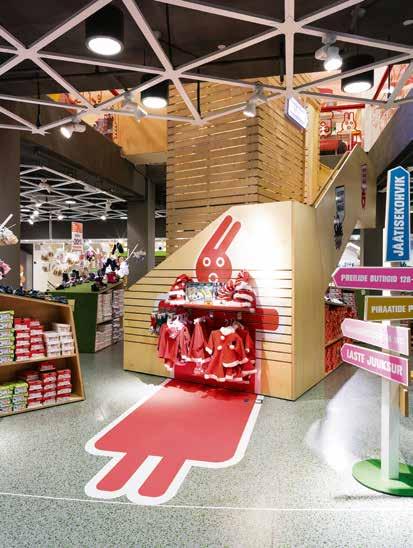
How old is the kid that should comprehend these urban landscapes? JR: The city is understandable to everyone. There are streets and houses with separate zones for boys and girls up to 16 years of age, babies separately, a separate shoe landscape. The logic is such that there should be some sort of point of attraction in each city district that will captivate children while their parent makes purchases. For instance, a play station automobile for boys that was build from scratch – we conducted experiments there with children to achieve the correct ergonomics. A creature resembling a lamb with a computer game is for girls. We create another passage with the bell tower, from where that world continues onward and upward.
Is it interesting to design merchandising space? Does the merchandise not bother you? Isn’t the space somehow cramped? JR: The worst is actually the “open theme”. Fitting in to a theme means that you have some sort of framework in front of you, and the denser it is, the more creative your work can be. There are very many variables that you have to take into account. I also like to think that the smaller the budget, the more you have to put into the work to come up with something good. The budget is usually limited in merchandising and thus it is a challenge for us. AL: That concentration suits me – as a rule, there is very little time for work and the theme is specific. In short, it is pleasant work.
Are you also parents? JR: I am. When we designed this, I wasn’t yet. After the fact I have perceived that some things went right. Children are not conservative. That is why another facet has been added to it, how to create different perspectives: eye height as a parent, which is restrained, logical and systematic, to which the grass roots level is added, where the child moves about. There we haven’t held ourselves back. There are plenty of details that would delight children.
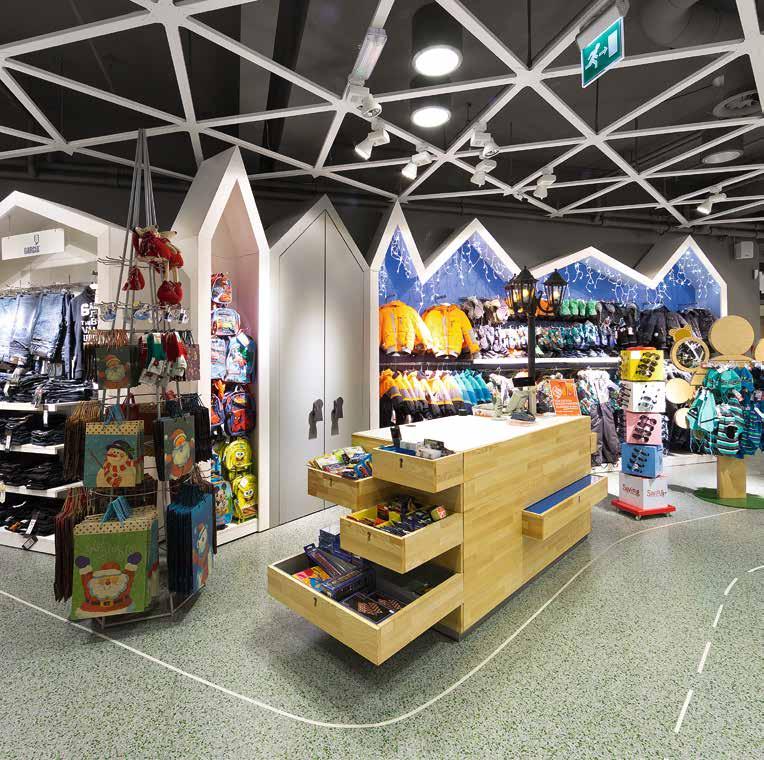
Nii nunnu! Ühteaegu tõsiseltvõetav ja üle võlli aetud lastemaailm on täpselt seadistatud, suisa hirmuäratavalt märki tabanud, peenelt doseeritud meeltemürk. Jaa, ka sisekujundus võib olla üsna ohtlik relv...
Tea Tammelaan, sisearhitekt ja ESLi aastapreemiate žürii liige
So cute! The children’s world is simultaneously credible and over the top. It is precisely furnished. It hits the mark altogether frighteningly, a precisely dosed narcotic. Yes, interior design can also be a rather dangerous weapon…
Tea Tammelaan, interior architect and member of the ESL annual awards jury
